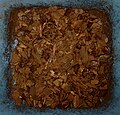Potting soil
Plant soil refers to an industrially produced humus-rich substrate for the hobby gardener and plant lover . This should ensure the fast and healthy growth of the plants used. Before the trade made ready-made products available, molehills were often used for this purpose because of the loose substrate .
Potting soil
Commercially available potting soil is made usually peat , lime , fertilizers and aggregates produced growing medium . Manufacturers are increasingly using compost , wood fibers , bark and, due to the growing price pressure, recycling material from various sources. Potting soil in which the peat is wholly or partially replaced by other substances is advertised as “peat-free” or “peat-reduced”. This happens against the background of peat extraction, which is problematic from an ecological point of view . However, it must be taken into account that the alternative aggregates are insufficient in terms of quantity to guarantee a complete replacement of peat in the hobby area. Especially since the quality is not always correspondingly good and, due to the competition between regenerative energies, many peat substitutes are also burned for the purpose of generating energy. In addition to "universal potting soil", the manufacturers offer a large number of products specifically aimed at certain areas of application. These differ in the type and amount of additives and in the fertilizer mix. Potting soil usually contains a balanced initial supply of an NPK fertilizer , which has to be replaced by fertilizers after a while. The same applies to potting soil that the higher-quality products usually cost a little more.
Potting soils, especially mixtures based on peat, sometimes contain too few trace elements . This deficiency can be compensated by adding primary rock flour .
A common practice is to mix universal potting soil with up to approx. 50 percent sand in order to obtain growing media for drought-loving plants ( cacti , succulents ) in an inexpensive way or to generally improve water drainage. Sands with little cohesive components are suitable for this process.
Special earths
Indistinguishable from those potting soils are growing earth and Rhododendron earth . The cultivation and sowing soil is particularly finely mixed and has a lower fertilizer supply, improved drainage and carefully selected raw materials, as seedlings and seedlings are more sensitive than plants to be repotted. Rhododendrons , azaleas and other bog dwellers need acidic soil. For this purpose, rhododendrons are less neutralized - i.e. the pH value is lower.
Orchid soil is usually a mixture of bark, wood fibers and other plant fibers and a small amount of peat, with a high proportion of coarse material. There are hardly any fine-grained components, which makes orchid soil fundamentally different from other potting soil.
Grave soil is a particularly dark potting soil for use in cemeteries. Frequently, the earth is colored dark by soot .
Potting soil is usually not sold by weight, but by volume. This is to prevent the supplier from stretching the product quantity with a higher water content. The density of universal potting soil is 400… 500 kg / m 3 .
photos
See also
Individual evidence
- ↑ NABU.de: Get active for more moor protection

